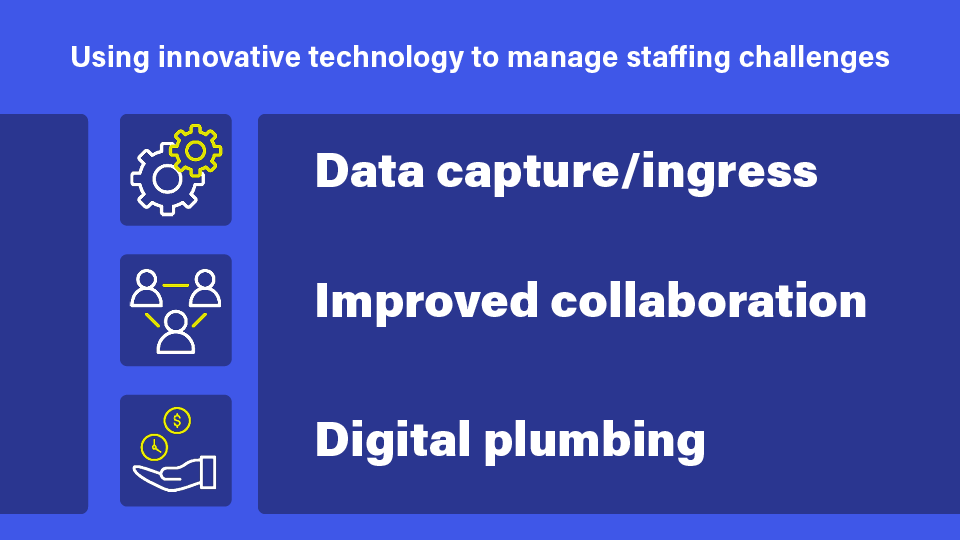Another year is coming to an end, and you know what that means: It’s time to revisit your firm’s strategic plans and identify action steps to ramp up your practice to thrive in 2024. One major task will be to manage staffing challenges.
Early indications point to many firms once again having record years despite dealing with a profession-wide staffing shortage that won’t be getting better any time soon (as confirmed by the latest AICPA study about accounting graduates). So, what moves can you make around staffing and productivity to optimize your firm’s strategic outlook for next year?
Steps accounting firms can take to manage staffing challenges
The obvious answers that seem to reverberate from the accounting profession’s management consultants are: using non-traditional hiring, right-skilling work, focusing on ideal clients and, of course, taking advantage of technological innovation.
Let’s start with those first three. Virtually every accounting firm is looking to hire more professional staff, making local competition for the limited graduate pool tougher than ever. This is pushing firms to alternatively hire remote and part-time workers. Firms are using outsourcing providers, many of which are offshore. While that move seems to be having an impact for the larger firms in the mix, it is not always an easy option for small and medium-sized firms.
Firms also have the option of “right-skilling” work by focusing tax professionals on doing higher-level, more complex work and pushing down their “rote” work to interns and an increasing number of administrative personnel. Experts anticipate that firms will increase the hiring of non-accounting personnel to do firm production tasks. That will alleviate some of the staff burden, but it won’t be enough to fill the widening staffing gap.
The importance of finding the ideal client

And just as professionals should focus on the appropriate level of work, firms should focus strategically on finding the appropriate clients to get them where they want to go. Every firm should consider updating its “ideal” client profile and type of service line. The ideal client is usually a highly profitable account that firms like to work with, particularly in niches where they can leverage learned expertise for more profitable work.
Also, while many firms have already terminated their “D” clients and are evaluating what to do about their “C” clients, the solution may be to focus instead on moving current “B” clients to “A” clients. It’s often the case that many of today’s “C” clients have been long-term loyal (mostly 1040-only) clients. However, if they cause you to burn out your staff, those employees might not be around to service ANY of your key clients next year.
Using innovative technology to manage staffing challenges

The fourth move (and one any size firm can take advantage of) is to use innovative technology to streamline those components of the practice that are ready for automation. There are three essential components:
Data capture/ingress
Standardizing the way data is captured by the firm via modern portals, secure email and e-signature apps allows the firm to manage ingress workflow more effectively. With these technologies, the firm doesn’t have to deal with a variety of divergent processes, many of which require expanded training of all staff. Centralized solutions managed by the administrative staff streamline the production of these components at a lower cost, allowing tax professionals to focus on higher-level tax advisory.
Improved collaboration
Effective digital work includes both the firm’s staff and clients and external partners using applications. All parties involved should be trained in using the firm’s collaborative digital applications to optimize data transfer and communications. In addition to tools such as Zoom and Microsoft Teams, the workflow components built into modern portals and secure email/digital signature solutions allow the firm to collaborate more effectively with clients. Firms can provide data in an electronic format with a time-stamped custody trail.
Digital plumbing
Few accountants entered the profession to become technology experts, but in many cases they are responsible for making decisions on the firm’s network design, equipment purchases, internet connectivity, and backup and disaster recovery. All of those technologies are evolving at an increasingly faster pace. Today, purpose-built clouds for the accounting profession provide enterprise-class technology, resources and depth of personnel. Firms can pay for cloud services via a “utilities model,” meaning they only pay for what they use and scale users up or down as needed.
Manage staffing challenges with a learning culture and new technologies
Finally, innovation and technical adoption take time and training, so firms must develop a learning culture. The firm needs to identify application and process champions to research and prioritize the solutions it adopts. Those champions can then provide learning documentation and training, and then follow up to ensure that the firm implements processes properly.
Without proactively identifying expertise/responsibility (and providing charge hour credit for their firm improvement efforts), all implementations underperform or stagnate. Adopting a “learning culture” is an absolute must for success.
All indications point to most firms experiencing an amazing year thus far and having an extremely positive outlook for 2024, except for the worsening staffing situation. By making a few key moves, firms can look for an even better year ahead, especially if they focus on innovative opportunities in technology.
Get started transforming your firm with technology today. Subscribe to our blog below.



